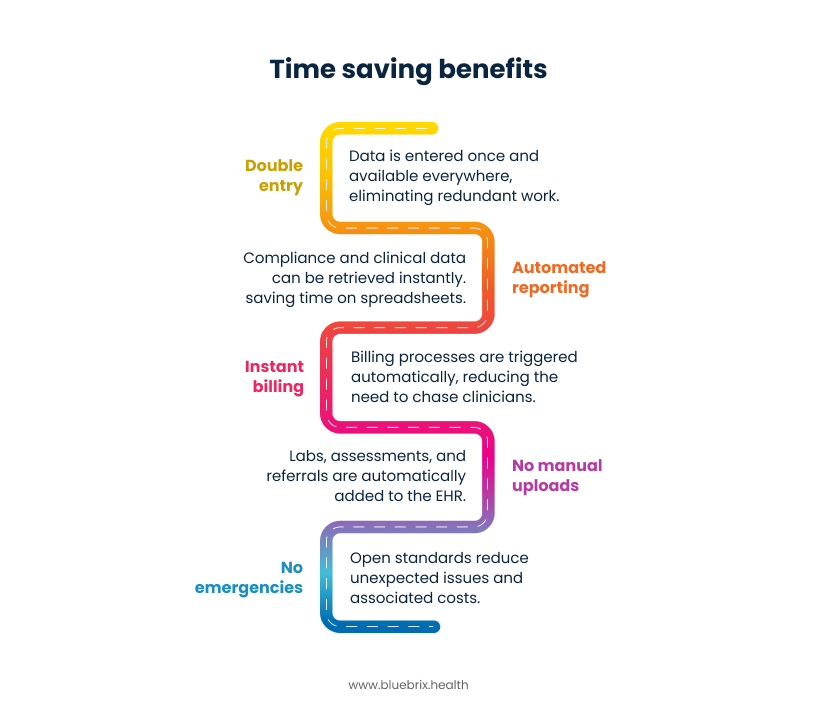
Let’s be honest, if you run a behavioral health clinic today, you’re probably already drowning in systems. There’s the EHR, the lab portal, the billing software, the scheduling calendar, the analytics dashboard and maybe a telehealth tool or two thrown in for good measure. Half your week is spent just trying to keep all of them talking to each other. If you ever feel like you spend more time fixing “tech stuff” than helping patients, you’re not imagining it. That’s the modern reality, and it’s eating up hours you’ll never get back.
But here’s the thing most consultants won’t say out loud:
Integrations aren’t a nice-to-have anymore. They’re non-negotiable.
Not the clunky, half-baked integrations that break the moment you need them, but real, seamless, behind-the-scenes connectivity that just works. And if you do it right? You can literally claw back 10, 12, sometimes even 15 hours a week, every single week.
Let’s break down exactly how seamless integrations change the game (and why your future self will thank you for caring about APIs).
Death by Manual Entry (and how to escape it)
Think about how much time your staff loses every week on pure grunt work, like:
- Copying data from one system to another.
- Manually uploading lab results.
- Pulling reports by hand, then re-entering the same patient info for billing or insurance.
Double entry isn’t just annoying, it’s a breeding ground for mistakes, burnout, and “who even knows what’s up-to-date anymore?”
This is where seamless integrations do what they’re supposed to: they kill manual work. When your EHR, billing, labs, and even external partners connect through a platform like blueBriX’s open, API-first system, data flows automatically in real-time.
That’s not tech-speak; that’s hours of human life you’re getting back. Your intake forms sync to your EHR. Lab results drop right into the patient’s chart, without needing email attachments or needing to log into three different websites. Insurance and billing get triggered the moment an appointment is marked complete.
If you’re the kind of person who counts pennies and minutes, do the math: even cutting out ten minutes of re-entry per patient, across dozens of patients a week, adds up fast. Multiply that by all the workflows (scheduling, reminders, assessments, follow-ups) and you’re not just saving time. You’re saving your mental health.
Real-Time Data = Real Decisions
Let’s be blunt, there’s nothing more frustrating or anxiety-inducing than making decisions with stale or incomplete data. Maybe a patient’s file isn’t updated because someone forgot to upload labs. Maybe insurance status didn’t sync in time, so you waste half an hour tracking down paperwork while the waiting room backs up. It’s all preventable, if your systems actually communicate with each other in real time.
That’s where integrations like blueBriX’s matter, because our platform isn’t some Frankenstein monster of duct-taped connectors. It’s built API-first, using healthcare standards like FHIR and HL7, which means it integrates seamlessly with labs, HIEs, payers, portals, and even ERP systems. The moment something updates in one system, it’s live everywhere else. No waiting, no lag, no “let me get back to you.” Your clinicians can actually trust what’s on the screen.
And the added benefit of this? That kind of real-time sync doesn’t just save you admin time, it lets you spot issues sooner, catch errors before they become problems, and make decisions that actually help your patients, not just your compliance officer.
Security, Without the Slowdown
Let’s address the elephant in the room, healthcare integrations are usually where security breaches start proliferating. You want data to flow, but you need it to stay locked down and compliant, because one breach and it’s not just HIPAA on the line, it’s your reputation and your livelihood.
Here’s where blueBriX doesn’t mess around. Our integrations are enterprise-grade secure, fully HIPAA compliant, and every single change has an audit trail. This means that you can let your systems talk to each other without worrying that your patients’ data is walking out the back door. You’re saving time and sleeping better at night. That’s a win-win.
Stop Paying Developers to “Glue” Your Systems Together
Here’s an uncomfortable truth that nobody likes to talk about: most “integrations” aren’t real. They’re just workarounds; custom scripts, unreliable middleware, or endless hours of developer time duct-taping APIs that were never meant to truly function in sync. You pay for the privilege, and it still breaks the moment someone updates their system or the rules change.
blueBriX does it differently. Our API-first, standards-based architecture means you (or your developers) aren’t going back to the drawing board every time you want a new integration. The documentation is actually readable, the endpoints are built to last, and the platform is open and developer-friendly. That means less “custom” work, fewer emergencies, and more predictable costs. That alone can save clinics thousands a year, not to mention all the Friday afternoons you won’t spend firefighting broken scripts.
The All-In-One, Actually-All-in-One Workflow
Let’s say you’re ready to take it all the way and that you want a clinic where intake, appointments, assessments, billing, telehealth, and analytics are all part of a single, unified workflow. With seamless integrations, you get exactly that. Schedule an appointment and billing triggers, reminders go out, the patient’s record is instantly updated everywhere. Lab results are in the chart the moment they’re available. Telehealth notes sync back to the main record, no manual copy-paste needed.
It’s not just about working faster. It’s about working efficiently, with less room for error, less stress for your staff, and a smoother experience for every patient who walks through your (physical or virtual) door.
Where Do the 10+ Hours Actually Come From?

You want specifics, not just inference. Here’s where the time gets saved:
- No more double entry. Data moves once, lives everywhere.
- Automated reporting. Pull compliance or clinical data with a click, not hours of spreadsheet wrangling.
- Instant billing triggers. No more chasing clinicians for encounter notes before sending claims.
- No manual uploads. Labs, assessments, and referrals drop right into the EHR.
- No developer emergencies. Open standards mean fewer costly surprises.
Across even a modest-size clinic, this adds up 10, 12, even 15 hours reclaimed from pure admin grind. That’s time you can reinvest into patient care, staff training, or even just letting your team bond.
Bottom Line
Seamless integration isn’t just a buzzword, it’s the difference between running a modern, efficient clinic and living in the unsustainable past. You can spend your time fixing problems your software created, or you can fix your software and get your time back.